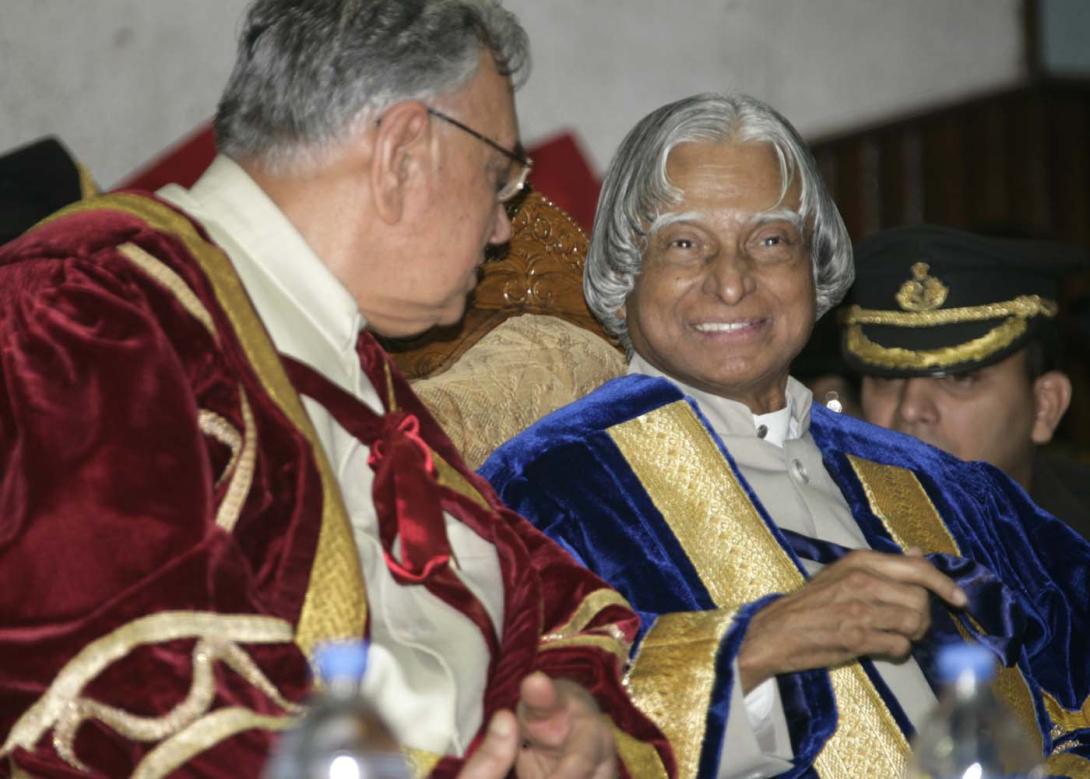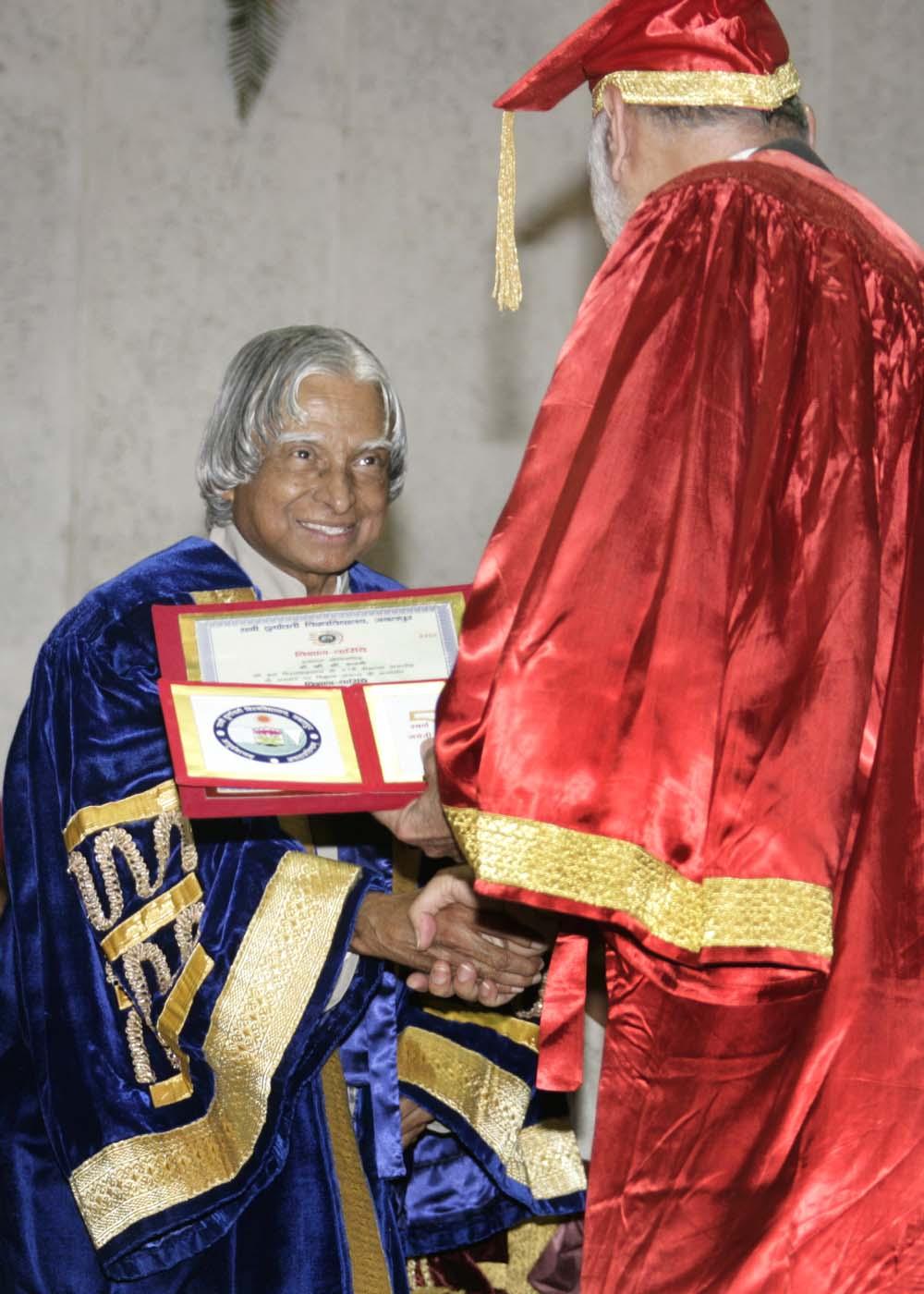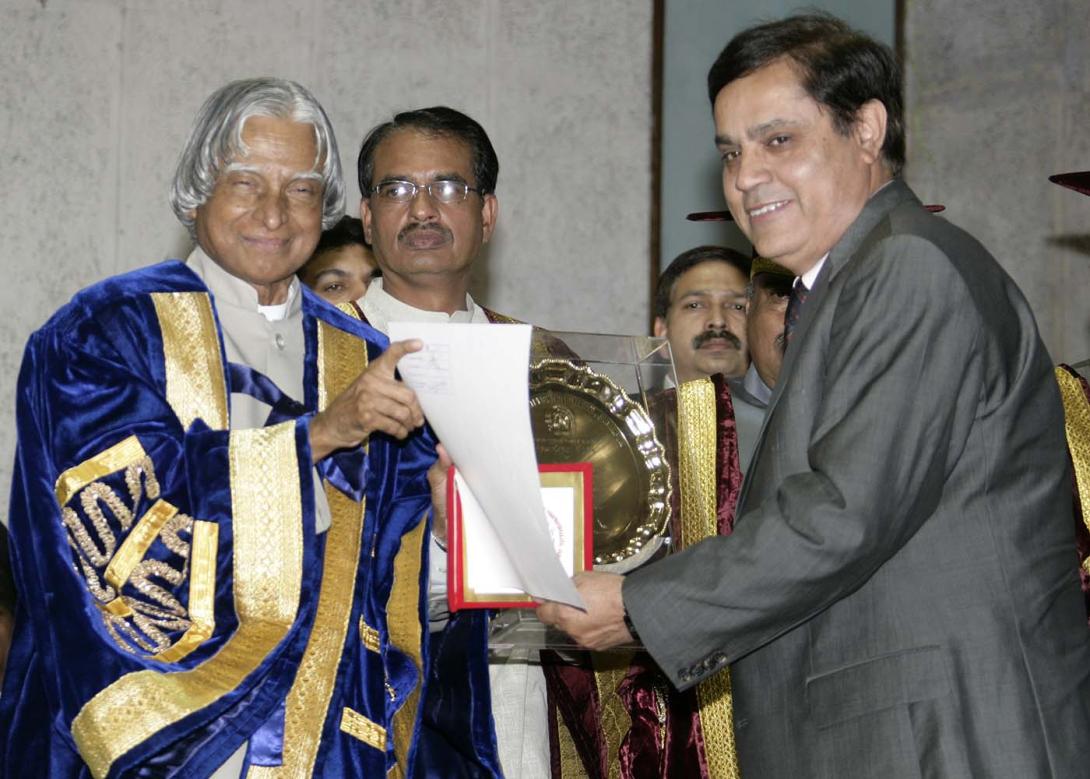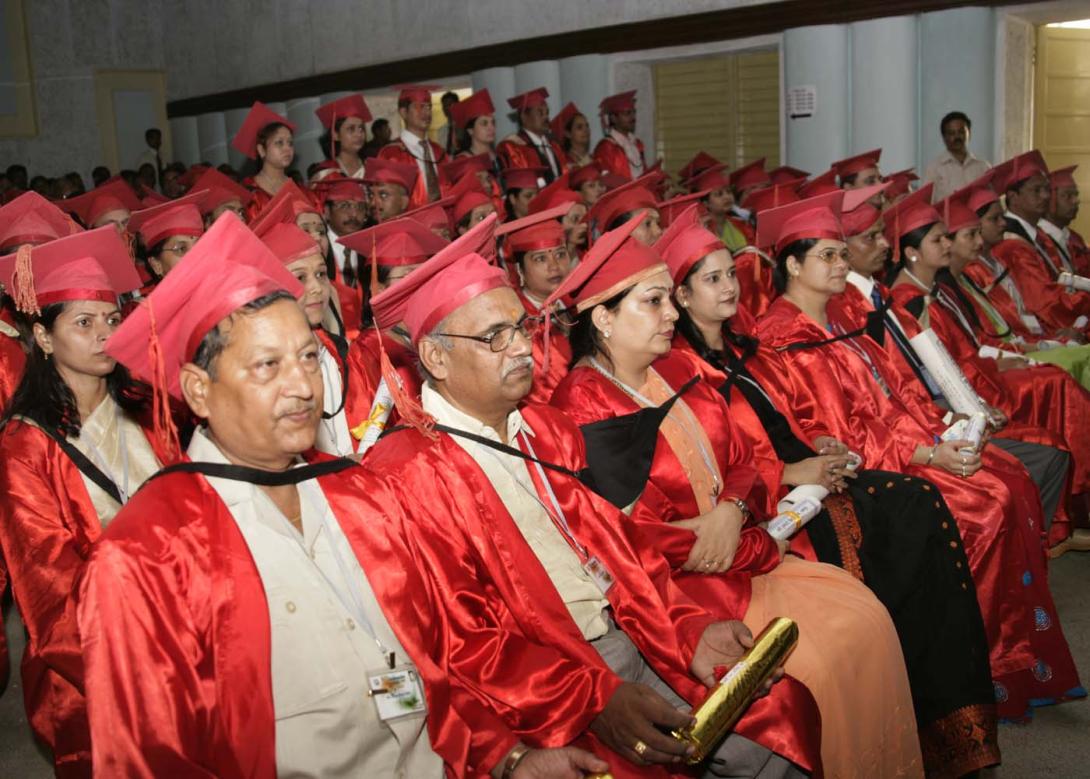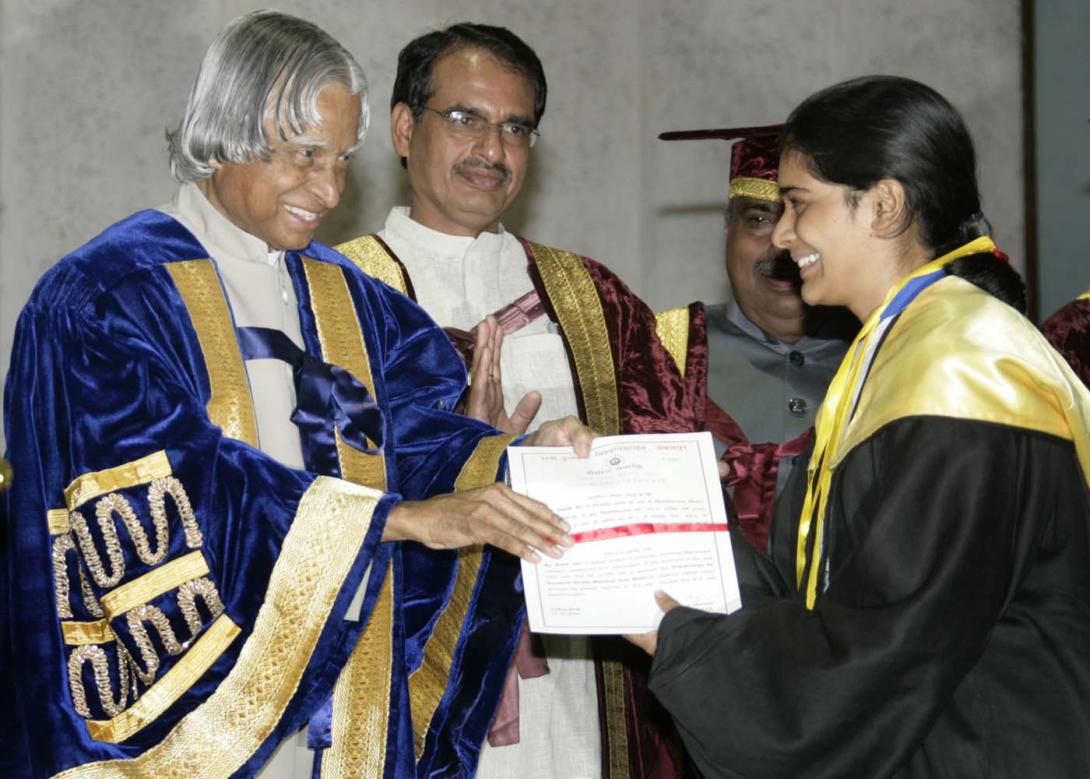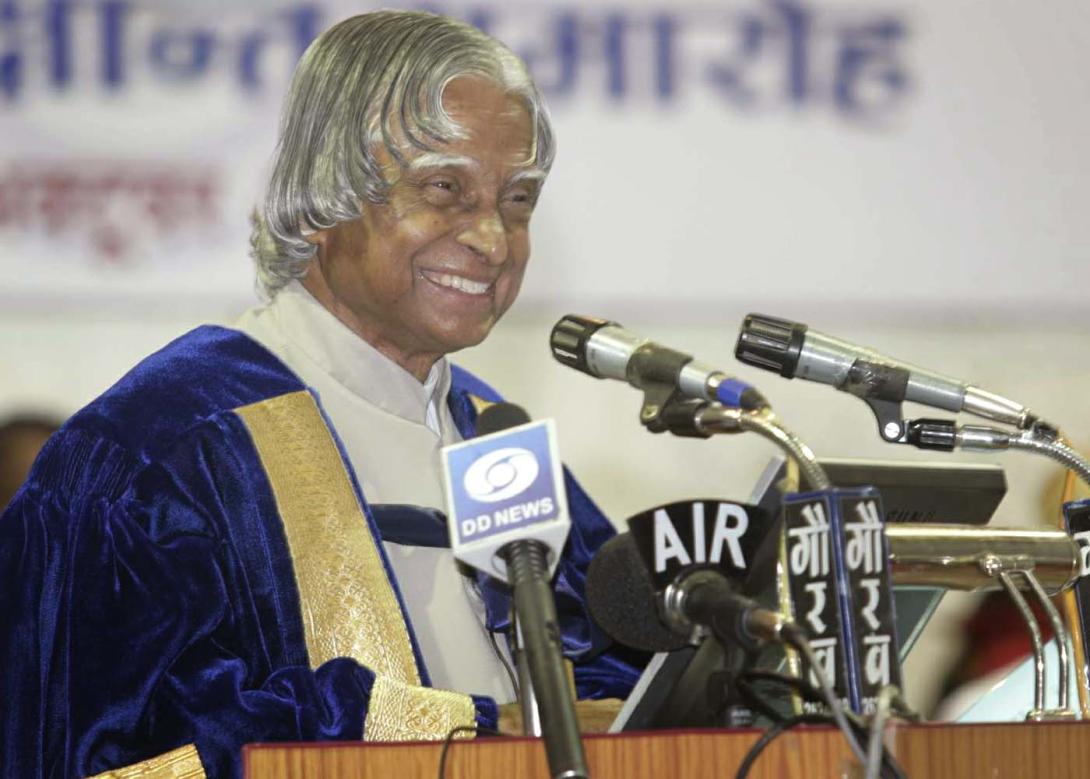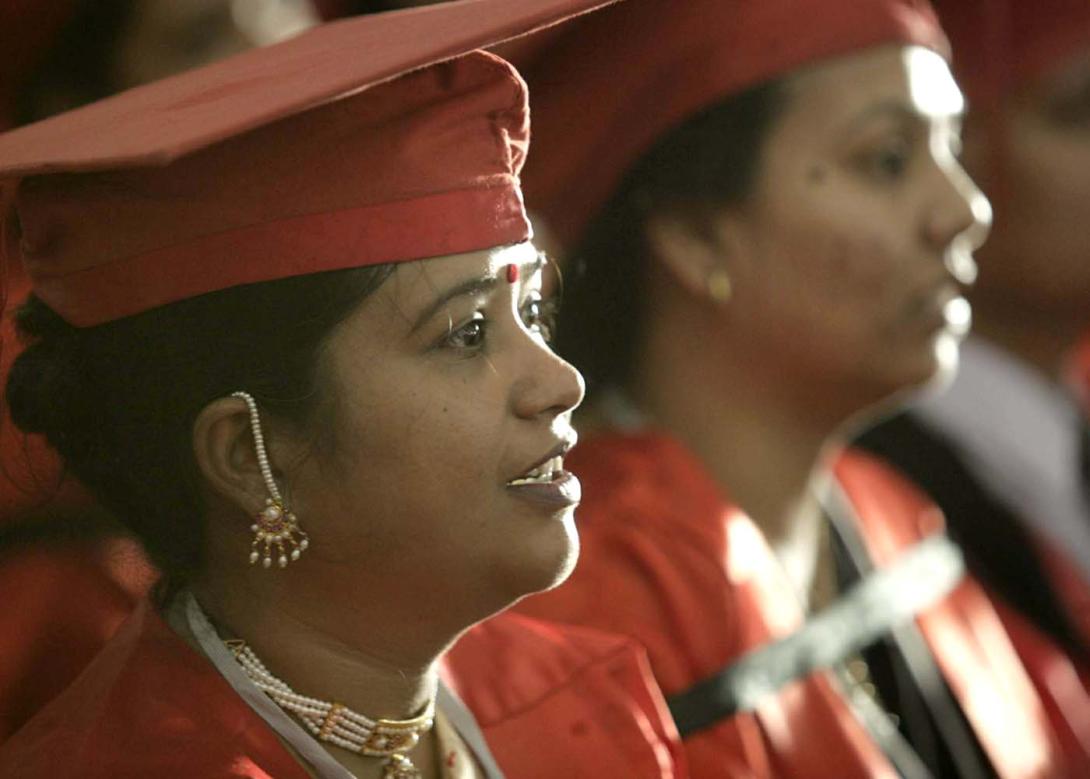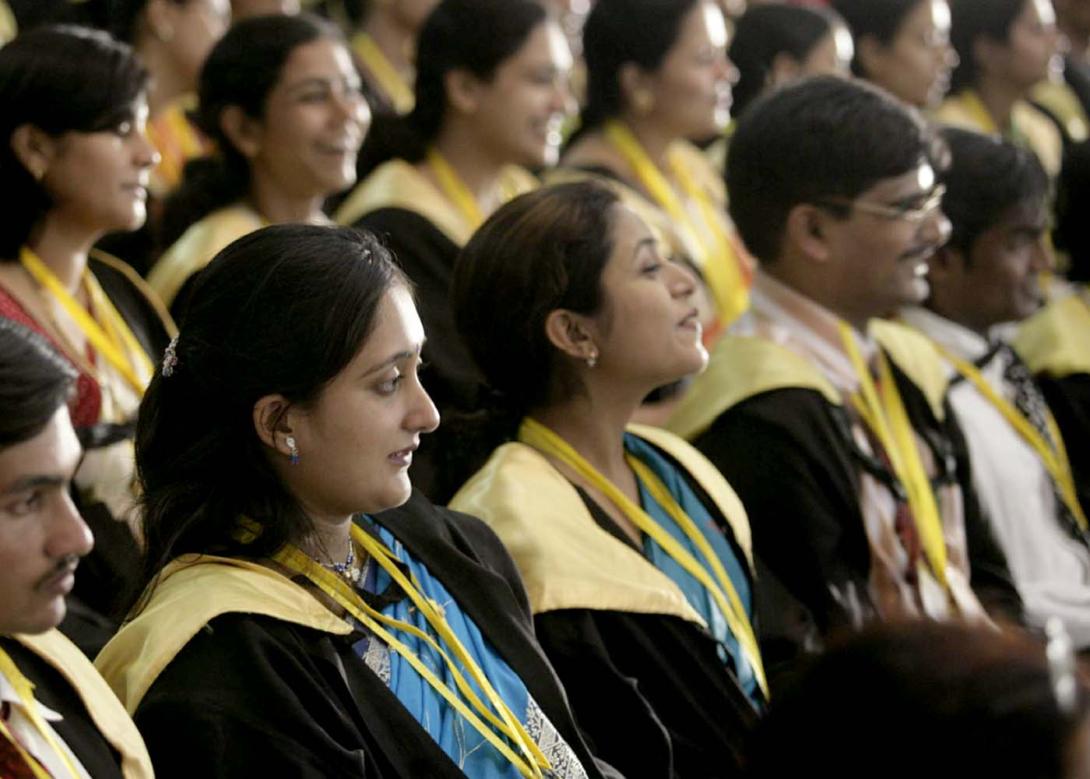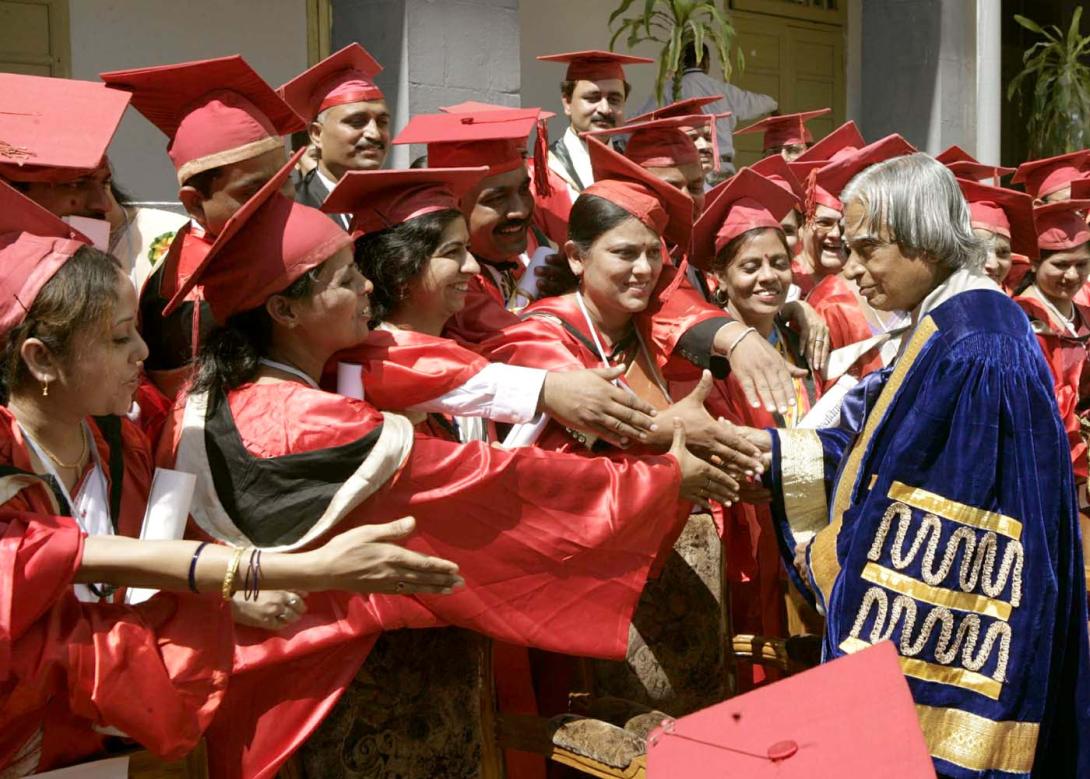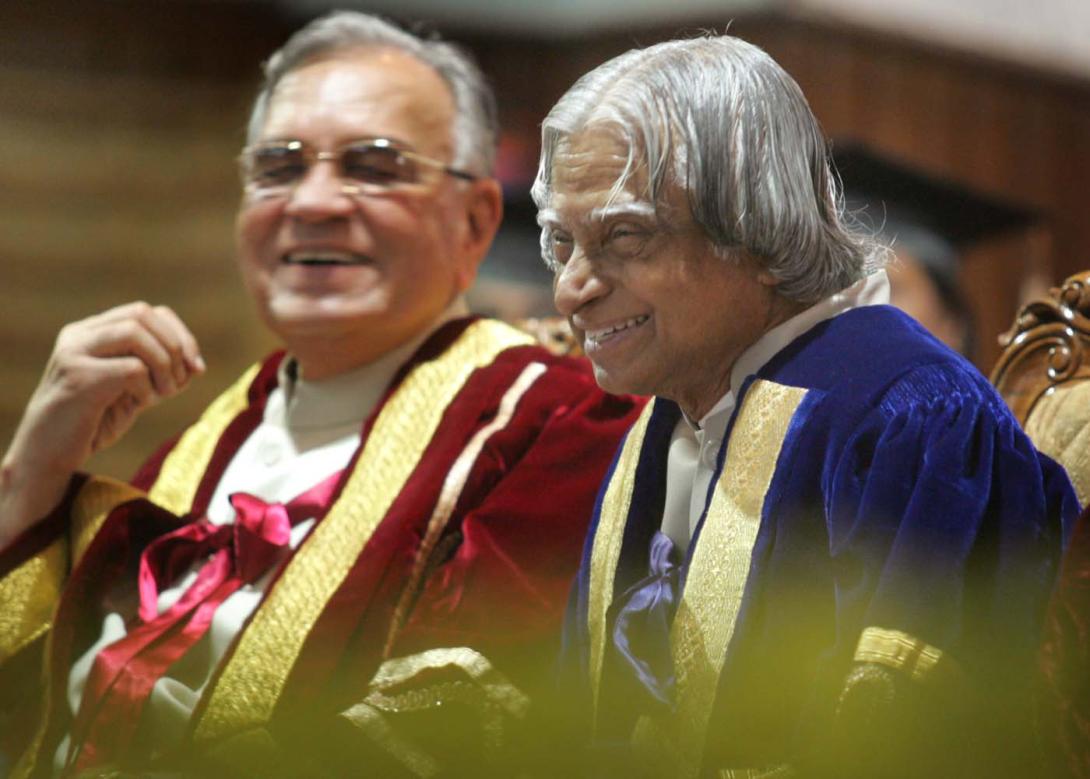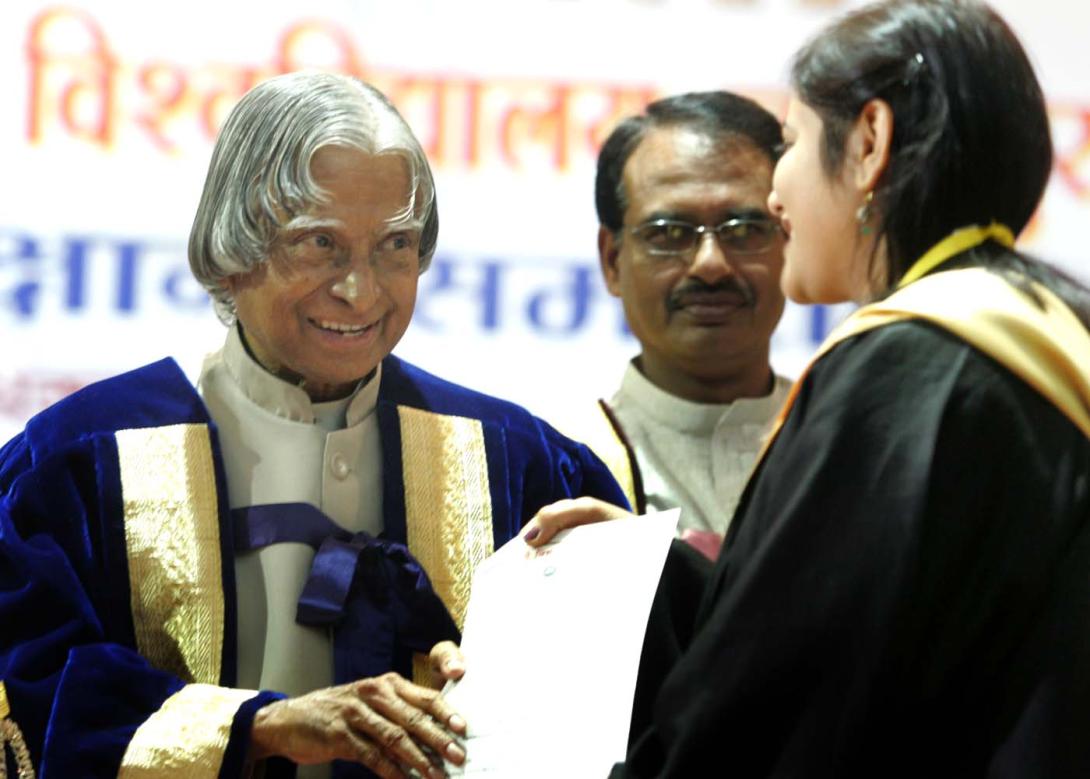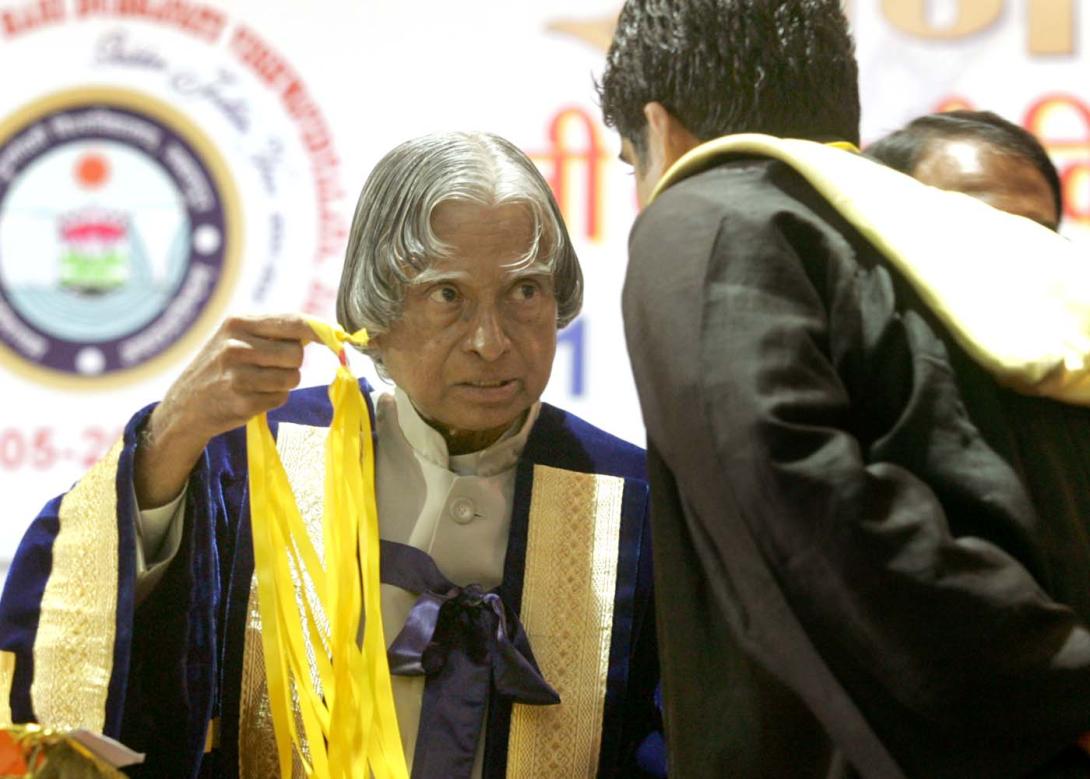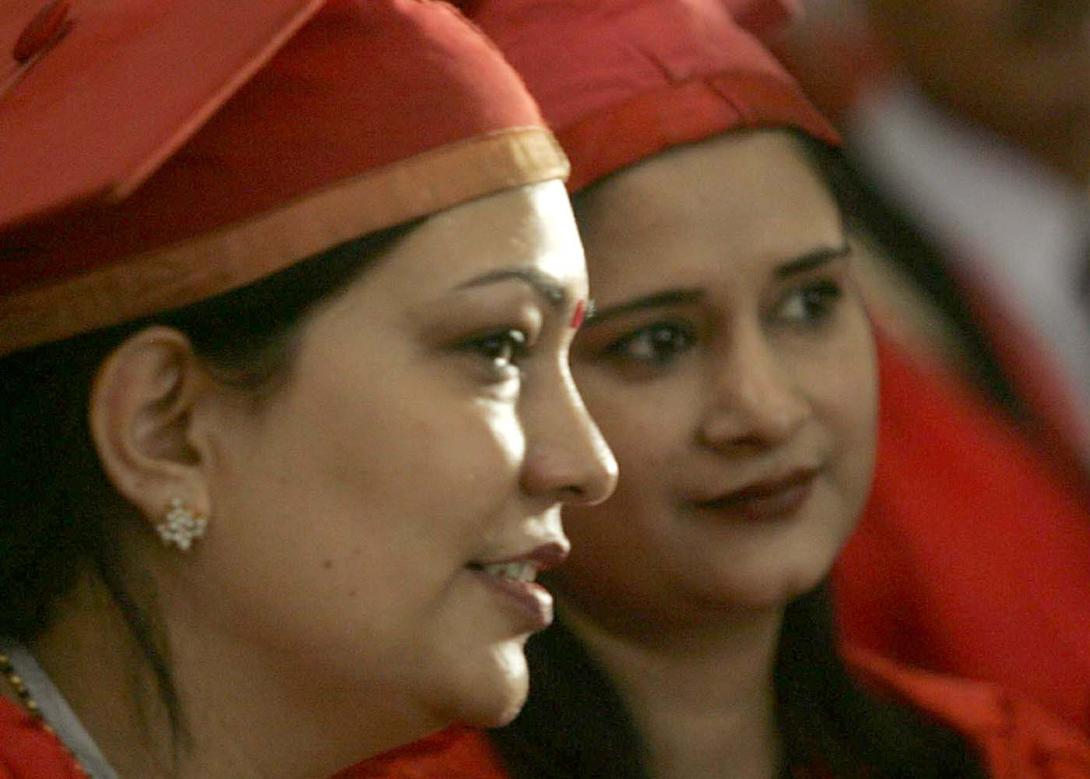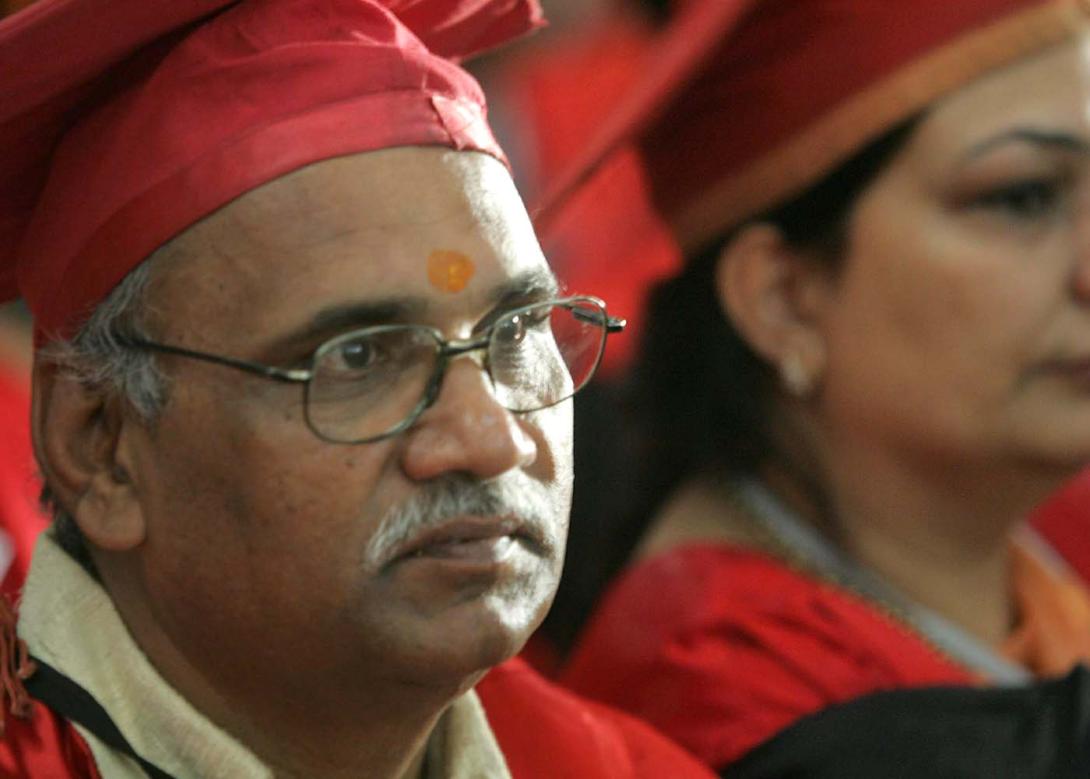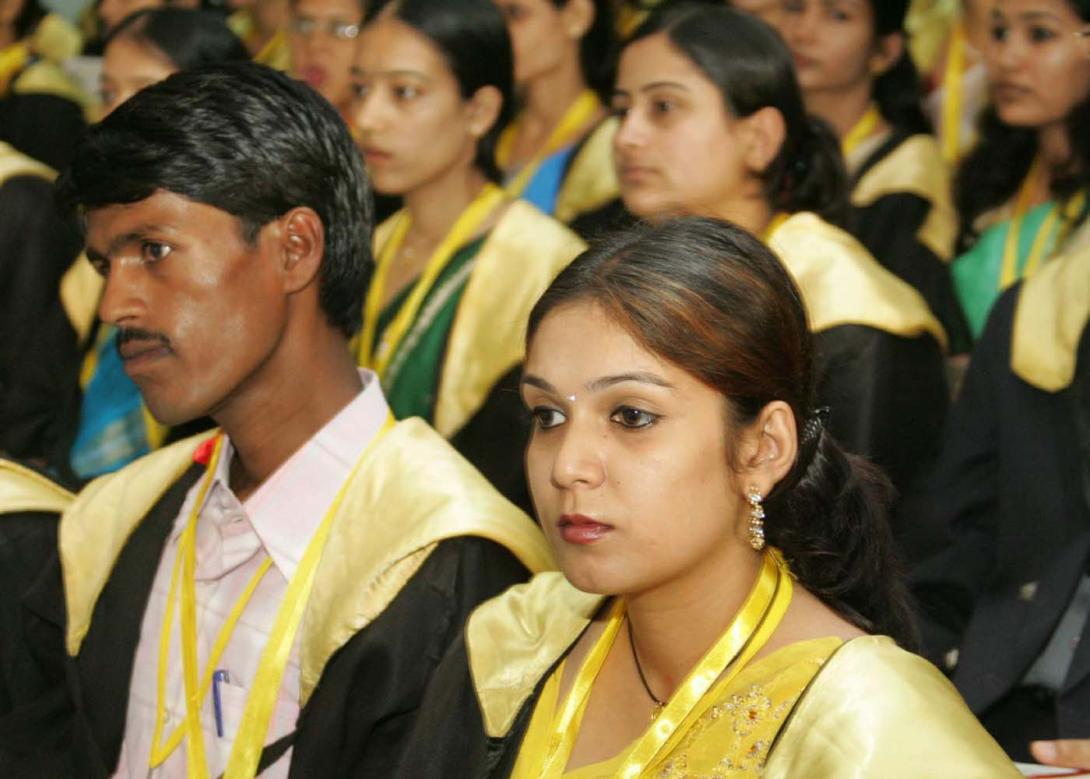Address at the Convocation of Rani Durgavati Vishwavidyalaya, Jabalpur, Madhya Pradesh
Jabalpur : 12-10-2006
Enriching Society through Education
I am delighted to participate in the Convocation of Rani Durgavati Vishwavidyalaya, Jabalpur during its Golden Jubilee Year. It gives me great pleasure to be here at this historical and cultural city of Jabalpur with a natural grandeur amidst you at this University named after a patriotic, brave and martyr, Durgavati. I take this opportunity to congratulate all the teachers, students and staff of this University and all those who have contributed in promoting excellence in educational standards of this University during last five decades. The University indeed has created many eminent teachers, professors, scientists, economists and many persons of excellence. My greetings to all of you. Today I would like to share with you the thoughts on "Enriching the Society through Education".
Research and Teaching
Any University is judged by the level and extent of the research work it accomplishes. This sets in a regenerative cycle of excellence. Experience of research leads to quality teaching and quality teaching imparted to the young in turn enriches the research. Research brings transformation and development and also enhances the quality of education. Both the research and teaching go together in good colleges and universities. I am sure Rani Durgavati Vishwavidyalaya will be known for their innovation in education and research task. Now, I would like to discuss the role to be played by the University in building capacity among our students.
Capacity Building
A good educational model is the need of the hour to ensure that the students grow to contribute towards the economic growth of a nation. Normally, research, technology and performance in the three sectors namely agriculture, manufacturing and services lead to economic growth. Can we sow the seeds of capacity building among the students? There will be continuous innovation during the learning process. To realize this, special capacities are required to be built in education system for nurturing the students. The capacities which are required to be built are research and enquiry, creativity and innovation, use of high technology, entrepreneurial and moral leadership.
Research and enquiry: The 21st century is about the management of all the knowledge and information we have generated and the value addition we bring to it. We must give our students the skills with which they find a way through the sea of knowledge that we have created and continue with life long learning. Today, we have the ability, through technology, to really and truly teach ourselves to become the life-long learners. This is required for sustained economic development
Creativity and innovation: The management of knowledge in the 21st century is beyond the capacity of a single individual. The amount of information that we have around is overwhelming. The management of knowledge therefore must move out of the realm of the individual and shift into the realm of the networked groups. The students must learn how to manage knowledge collectively. When the information is networked the power and utility of the information grows as square as stated by Metcalfe's law. Information that is static does not grow. In the new digital economy information that is circulated creates innovation and contributes to national wealth. In this connection, I am happy to note that the Rani Durgavati University is a partner in the Interact India Programme (IIP) which envisages integration of international/intercultural dimensions into the teaching, research and service functions of the education system. This could promote spread of the values and culture and could help create better mutual understanding at global level. Ancient India in places like Nalanda University successfully experimented such interaction and attracted a number of foreign students.
Capacity to use high technology: Every student in our colleges should learn to know how to use the latest technologies for aiding their learning process. Universities should equip themselves with adequate computing equipment, laboratory equipments, and Internet facilities and provide an environment for the students to enhance their learning ability. In the midst of all of the technological innovations and revolutions we cannot think that the role of the teachers will be diminished. In fact the teacher will become even more important and the whole world of education will become teacher assisted and would help in ?tele-porting? the best teacher to every nook and corner of the country and propagate the knowledge.
Entrepreneurship: The aptitude for entrepreneurship should be cultivated right from the beginning and in the university environment. We must teach our students to take calculated risks for the sake of larger gain, but within the ethos of good business. They should also cultivate a disposition to do things right. This capacity will enable them to take up challenging tasks later.
Moral leadership: Moral leadership involves two aspects. First it requires the ability to have compelling and powerful dreams or visions of human betterment. Moral leadership requires a disposition to do the right thing and influence others also to do right things.In sum, inquiry, creativity, technology, entrepreneurial and moral leadership are the five capacities required to be built through the education process. If we develop in all our students these five capacities, we will produce ?Autonomous Learner? a self-directed, self controlled, lifelong learner who will have the capacity to both, respect authority and at the same time is capable of questioning authority, in an appropriate manner. These are the leaders who would work together as a ?Self-organizing Network? and transform any State as a prosperous State. The most important part of the education is to imbibe the confidence among the students is the spirit of ?we can do it?. These capacities will enable the students to meet the challenges of our national mission of transforming the nation into a developed country by 2020.
Our National mission - challenges
Our nation is going through a major challenge of uplifting of 220 million people who are below the poverty line and also to give better life for many millions who are on the border line of poverty or just above the poverty line. They need decent habitat, they need work with reasonable income, they need food, they need health care, and they need education and finally resulting into a good life. Our GDP is growing at more than 8% per annum on an average. Whereas, the economists suggest that to uplift the people from below the poverty line, our economy has to grow at the rate of 10% per annum consistently, for over a decade.
Integrated action: We have the mission of transforming India into a developed nation. For this we have identified five areas where India has core competence, for integrated action: (a) agriculture and food processing; (b) education and healthcare (c) information and communication technology (d) reliable and quality electric power, surface transport and Infrastructure for all parts of the country and (e) Self reliance in critical technologies. These five areas are closely inter-related and will lead to food security, economic security and national security.
I had presented to the Legislative Assembly of Madhya Pradesh on 17 July 2006, 11 missions based on the following principles :-
(a) Method of increasing the per-capita income of the State to Rs. 50,000 from Rs. 14,000 by 2010.
(b) Improving the Human Development ranking of Madhya Pradesh from the present 12 to less than 5.
(c) Realizing the goal of total literacy before 2012 by the giving highest priority to women's education, particularly the tribal population.
(d) Empowering all tribal citizens with quality education, healthcare and employment potential.
(e) Progressively reducing the number of people living below the poverty line from the existing 40 percent to near zero by 2016.
Rani Durgavati Vishwavidyalaya can study the 11 missions and can provide the knowledge products to the Government and Industry for enhancing the economic prosperity of the State. One of the important components of development is the creation of PURAs (Providing Urban Amenities in Rural Areas) in which the University can participate. I would like to present the salient feature of three PURA complexes which I have seen in different parts of the country.
Periyar PURA
I had visited Periyar Maniammai College of Technology for Women, Thanjavur in Tamil Nadu and inaugurated a PURA Complex. I thought of sharing with you the developmental concept of a cluster of over 65 villages near Vallam, Thanjavur district of Tamilnadu which involves a population of 3 lakhs. This PURA complex has all the three connectivities - physical, electronic and knowledge - leading to economic connectivity. The centre of activity emanates from the women?s engineering college that provides the electronic and knowledge connectivity. I understand that now five of the Periyar PURA villages have been connected with Wi-MAX connectivity. Periyar PURA has health care centres, primary to post graduate level education and vocational training centres. This has resulted in large scale employment generation and creation of a number of entrepreneurs with the active support of� 850 self-help groups. Two hundred acres of waste land has been developed into cultivable land with innovative water management schemes such as contour ponds and water sheds for storing and irrigating the fields. All the villagers are busy in cultivation planting Jatropha, herbal and medicinal plants, power generation using bio-mass, food processing and above all running market centres. This model has emanated independent of any government initiative. The committed leadership has been provided by a Women?s Engineering College. Now, I would like to discuss about Byrraju PURA established at Bhimavaram in Andhra Pradesh.
Byrraju PURA
Byrraju Foundation of Satyam near Bhimavaram has undertaken the mission of establishing 32 Ashwini centers benefiting 116 villages with the population of around 500,000 people. It has provided the electronic connectivity through wireless (512 kbps to 2 mbps), knowledge connectivity in cooperation with National Academy of Construction, Hyderabad and other domain experts, thereby creating economic connectivity in these villages.
Economic Connectivity: During the last 4 years of its operation, it has skill enabled and knowledge enabled in areas such as construction, tailoring, garment production, IT and spoken English skills. This programme resulted in 3000 jobs with the minimum earning of Rs. 3000 per month, this is 3 times that of their earlier earning potential. A rural BPO Gram IT, established in Jallikakinada center has trained the unemployed graduates in IT skills and spoken English and employed 100 people to do the BPO operations such as transaction processing of Human Resource data of Satyam Computers as a back office processing; data processing of one million self-help-group members of Andhra Pradesh such as financial data, accounting data, spending pattern, cultural aspects under the programme of ?Mapping the bottom of the Pyramid?. This Gram IT BPO has effected the 10% reverse migration from Hyderabad to Bhimavaram. Now, I will talk about Chitrakoot PURA.
Chitrakoot PURA (Madhya Pradesh): Shri Nana Deshmukhji (Age 90) and his team members belonging to Deendayal Research Institute (DRI) have created Chitrakoot PURA in Madhya Pradesh. DRI is a unique institution developing and implementing a village development model, which is most suited for India.
DRI understands that people's power is more potent, stable and enduring than political power. By becoming one with the oppressed and depressed, one gains the acumen of administration and governance. Social advancement and prosperity are possible only by injecting the spirit of self-reliance and excellence in the younger generation. Using this principle, DRI has plans to develop one hundred clusters of villages having approximately five villages each around Chitrakoot. They have already developed 80 villages in 16 clusters consisting of about 50,000 people.
There is a village called Patni where DRI has promoted sustainable development based on indigenous and traditional technology, knowledge systems and local talents. The research work by the institute through field studies facilitates the development of replicable and tangible model for achieving self-reliance in villages. The programme aims at income generation through value addition, innovative agricultural practices, inculcating scientific temper among the villagers, improvement of health and hygiene, striving towards 100% literacy. As a part of integrated rural development, the villagers are doing water harvesting; effectively use it for cultivation of food grains, medicinal and aromatic and horticulture cultivation. Apart from all these development activities, the institute is facilitating a cohesive conflict free society. As a result of this, eighty villages around Chitrakoot are almost litigation free. The villagers have unanimously decided that no dispute will find its way to court. The differences will be sorted out amicably in the village itself. The reason given by Nana Deshmukhji is that if the people fight among each other they have no time for development. They can neither develop themselves nor the community. This message has been understood by the society and they have decided not to embark on any fighting. All these have been accomplished through DRIs ?samaj-shil-pi dampati? (a graduate married couple) a new concept of counseling and intervention promoted by DRI. A new road connecting multiple villages in the Chitrakoot area is taking shape.
Rani Durgadevi University has a good insight into personal laws of tribals, their socio-economic structure, their political institutions, their history, culture, religious practices and beliefs. For this purpose the University is carrying out inter-disciplinary studies. Also as a part of the Gandhian study centre, I note that you have been making an in-depth study of Gandhiji?s thoughts on upliftment of poorer section of the society, economic aspects of the village industries, health dimensions of rural population and non-violence. With these back grounds, Rani Durgavati Vishwavidyalaya can consider creating one PURA each in the seven districts of Jabalpur, Revenue Division namely Katni, Mandla, Dindori, Narsinghpur, Balaghat, Seoni and Jabalpur using the talented youth and faculty members available in the Vishwavidyalaya and its affiliated colleges. The aim of creating such PURA should be to enhance the literacy rate from the existing 51% to 75%, increasing the per-capita income of the districts from the existing Rs. 14,000 to Rs. 50,000 and reducing the number of people below poverty line to 20% from the existing 40% by the year 2010. The University may nominate nodal colleges in each of the seven districts for creation of the PURA covering 15 to 20 village clusters having a population of 30,000 to 50,000. The nodal college can workout the physical connectivity, electronic connectivity and knowledge connectivity needed in the selected village cluster for realizing economic connectivity and work with State Government, NGOs and financial institutions for establishing the PURA as a viable business proposition. For providing remunerative economic activity the nodal colleges can examine the core competence of each village and work on the ?one product ? one village? scheme presently being experimented in Chhindwara and Seoni with the help of JETRO of Japan. In essence, the one lakh students of Rani Durgavati Vishwavidyalaya can provide knowledge input for the upliftment of 100 lakh people living in the seven tribal districts of Madhya Pradesh. This will become a live example of contribution of youth towards societal transformation. This is especially possible since the University has all the disciplines such as engineering, medicine, life sciences, arts, management, law, humanities, commerce and others in one campus.
Conclusion: Indomitable Spirit
Now, I would like to recall a great clarion call of indomitable spirit, which was given by Nobel Laureate Sir C.V. Raman, at the age of 82. The message is still reverberating in my mind: ?I would like to tell the young men and women before me not to lose hope and courage. Success can only come to you by courageous devotion to the task lying in front of you. I can assert without fear of contradiction that the quality of the Indian mind is equal to the quality of any Teutonic, Nordic or Anglo-Saxon mind. What we lack is perhaps courage, what we lack is perhaps driving force which takes one anywhere. We have, I think, developed an inferiority complex. I think what is needed in India today is the destruction of that defeatist spirit. We need a spirit of victory, a spirit that will carry us to our rightful place under the sun, a spirit, which will recognize that we, as inheritors of a proud civilization, are entitled to a rightful place on this planet. If that indomitable spirit were to arise, nothing can hold us from achieving our rightful destiny.?
My congratulations to all the graduates who are passing out from this Vishwavidyalaya today and my best wishes to all the members of Rani Durgavati Vishwavidyalaya in their mission of providing quality education and capacity building of the youth of the seven tribal districts of Jabalpur Revenue Division.
May God bless you.

